A few years ago, I wrote about the recurring problem of the overburdened infantry soldier, noting that;
As noted in every single one of the studies going back to the Crimean War, soldiers perform the basic tasks of soldiering more poorly the more they are overburdened, it cannot be said any clearer than that.
The article described many strategies for reducing carried weight, especially for light role infantry; Carry less stuff, Make stuff easier to carry, Make stuff lighter and Get someone or something else to carry the stuff
Each of these is a valid approach to the enduring problem, lighter plates and radios might yield significant reduction but NLAW, water and 7.62 mm link aren’t likely to get lighter. With future counter-UAS, ECM and communications equipment, and a desire to integrate loitering munitions and retain mortars in the infantry, these shared weights are not getting lower, indeed, they seem to be rising. This means the last strategy will be increasingly needed.
This blog post will look at load carriage support platforms, specifically at the light role platoon and company levels. Organisational structures tend to evolve to meet operational requirements but to generalise; a light role infantry Company consists of a Company HQ and three rifle platoons. The rifle platoon consists of a platoon HQ and three rifle sections for a total of 30 individuals. At the Battalion level, there will also be a collection of support functions such as medical, QM’s, ATGW and mortars. Although light role infantry, do not, by definition, have integral vehicles at the company and platoon level, they have more recently utilised quad bikes and trailers, providing some casualty evacuation and light store carriage support for dismounted sections.
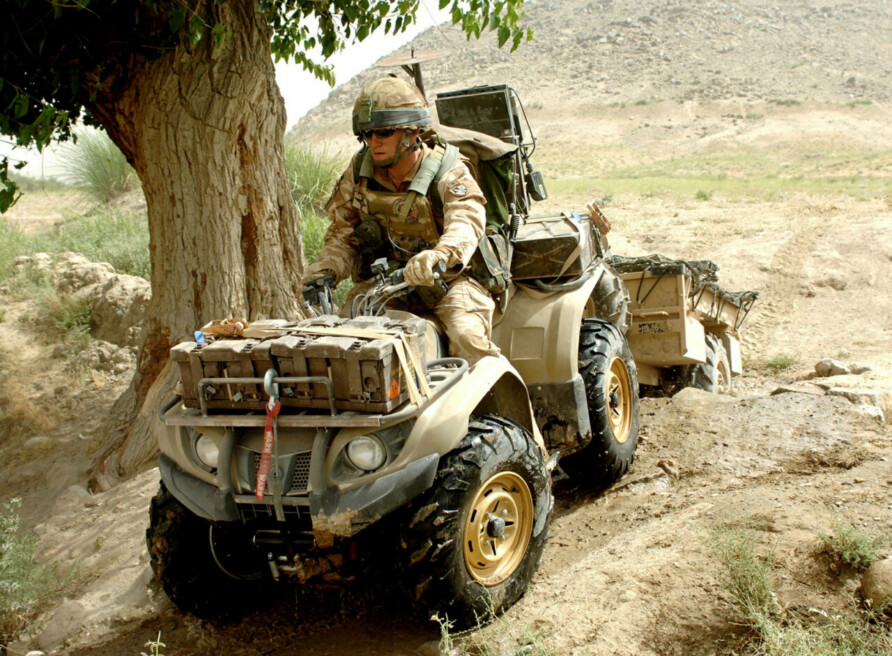
I am going to avoid discussion on larger vehicles like pickup trucks, Land Rover replacements, JLTV and other similar options that turn role infantry into light role cavalry or some form of light mechanised infantry, the subject of another post, perhaps.
And, no mules, e-bikes, handcarts, cargo UAS or hover boots either (although all are worthy of discussion)
Describing a Requirement
After the 1982 Falkland Conflict, the MoD defined a requirement for an all-terrain load carrier, recognising the gap that left soldiers and marines walking huge distances over poor terrain whilst carrying the heaviest of loads. The Esarco 8×8 and Supacat ATMP competed and eventually, the All-Terrain Mobility Platform (ATMP) entered service. ATMP was used in the 1991 Gulf War, operation in the Balkans in the Nineties and the 2003 invasion of Iraq. It was also used in Afghanistan, but lack of spares meant it was eventually replaced by Springer, a rare UOR failure.
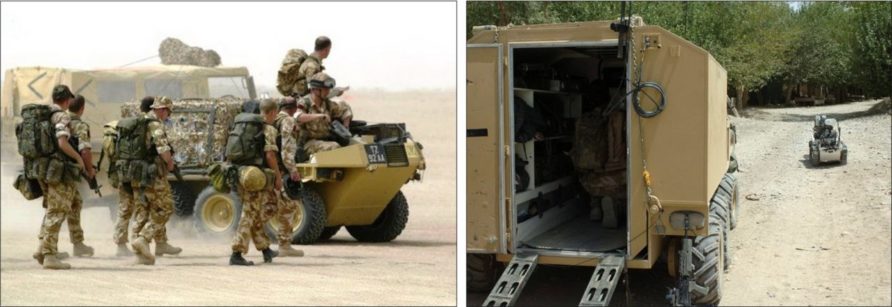
Yamaha quad bikes and Logic trailers were then used extensively where they proved to be enormously useful for running replens, casualty evacuation, transferring stores to and from helicopter landing sites and a million other odd jobs. They were especially useful in close terrain, narrow tracks and such but in the Green Zone, with its many drainage and irrigation ditches, mobility was often impaired. To address this, lightweight gap crossing equipment (Gap Crossing Capability Short – Quad (GXC(S) Quad)) was obtained from Mauderer in Germany, or aluminium ramps to you and me.

Commenting on the use of quad bikes, Major Matt Cansdale, 3rd Battalion, Parachute Regiment, said;
The quad bikes proved to be reliable and able to go places that no other vehicle could. The equipment that the quad bikes were able to carry enabled us to launch patrols that covered more distance and were longer in duration than would otherwise have been the case, so we were able to push into areas that the enemy did not expect us.”The ability to evacuate casualties effectively and quickly also meant that we could move away from established routes while limiting the risk to our forces
Since then, all three services have continued to use quad bikes.

For example;
Dragon Coy, 1 MERCIAN, deployed as the ISTAR Gp in Estonia operate approximately 20 quads for snipers, assault pioneers, mortar platoon MFCs and Royal Artillery JTAC’s. The quad enable us to exploit the narrow tracks and fire-brakes of the forest and compliment the firepower and protection from Recce & ATk Pl Warriors.
1 MERCIAN is an armoured infantry battalion but this shows how innovation in all types of unit can be enabled by such vehicles.
Multiple development programmes have been initiated by different parts of the MoD over the years, with some inevitably crossing over as a de-risking approach, and gaining insight into the specific differences is not always simple.
The Robotic Platoon Vehicle (RPV) is one such programme, being coordinated by the DE&S Future Capabilities Group (FCG).
Test and evaluation of military vehicles. Training and simulation in military vehicles. Dstl intends to hire a Robotic Platoon Vehicle (RPV) with accompanying technical support and training, which is capable of being armed with a medium or heavy machine gun and has a Surveillance, target acquisition (STA) system capable of detecting a human up to 2 km away in all light conditions. DSTL expects the RPV to be able to operate within a dismounted infantry section/platoon and is able to traverse terrain associated with Dismounted close combat (DCC) in both the urban and rural environments.
QinetiQ Milrem, Rheinmetall and Horiba, together with systems and vehicles from a number of others, are being evaluated.
Project Theseus, another.
Project THESEUS aspires to define and deliver Defence with an end-to-end highly automated ground and air resupply network, enabled by a logistic information system; 24/7 and in all conditions. THESEUS’ main aim being to investigate the potential to apply autonomy to the ordering, planning and delivery of supplies between the requestor (in this case military personnel engaged in warfighting) and the warehouse (in this case a Forward Operating Base). This project should therefore increase the flow and efficiency of delivery on the battlefield (at the minimum a 15km x 15km area).
Important to note that Theseus includes both ground and air vehicles
The ground element of Theseus includes vehicles from Horiba MIRA (Viking) and QinetiQ/Milrem (Titan)
The Expeditionary Robotics Centre of Expertise (ERCoE) will coordinate these activities, with RPV was working across three development spirals;
- Load carriage(5 different platforms)
- Weapon (2 platforms)
- STA
The Army’s new Enhanced Light Force Battalion is 2 YORKS.
Lt Col James Ashworth, Commanding Officer of 2 YORKS, said: “2 YORKS has just started their journey of trials and experimentation as the Army’s Enhanced Light Force Battalion. This has initially seen work with the new A3 rifle, the ARILLS sight that combines both Image Intensifying and Thermal capabilities, and the Dismounted Situational Awareness technology that brings unrivalled connectivity between soldiers and their commanders. “The next period of experimentation will include a fleet of six Robotic Platoon Vehicles (RPV) that have just arrived in Cyprus where 2 YORKS are based.”
The Future Soldier programme is a £120 million initiative, ambitious in its scope.
The UK is therefore currently evaluating the Rheinmetall Mission Master Cargo, MIRA Viking, Hippo-X, Marlborough (Praesidium Global MAPS) and QinetiQ Titan (Milrem Themis) UGV’s under the Robotic Platoon Vehicle (RPV) programme. The robotic version of the Hippo-X is being developed in conjunction with Pearson Engineering, Digital Concepts Engineering and Torc Robotics. They are all impressive vehicles, and no doubt the British Army is building up a solid bank of evidential learning. Two of these are also under trial under a separate programme (Theseus). As can be imagined from above, the distance between an overburdened soldier today and the realisation of any solution delivered by the ambitious Future Soldier programme is significant and growing, growing because the problem has been subsumed into an assumption that it can only be met by autonomous or robotic solutions. Meanwhile, quad bikes purchased many years ago continue to be used, despite them being recognised by the Army’s own research to be inadequate.
This is why I start to diverge from current orthodoxy;
ONE; The problem exists today
TWO; Solutions are also available, today, that do not need £120m research programmes to realise
I am certainly not dismissing the work currently being carried out under these various programmes, just pointing out that the problem exists today and could be resolved with simple off the shelf equipment, even if only as a placeholder. And so on that basis, a set of requirements can be described, and then compared against a number of options.
The basic requirement can be framed against five elements; Deployability, Payload, Mobility, Adaptability and ‘others’
1 – Deployability
As I mentioned above, this is not about giving every soldier in the Light Role Infantry Battalion a seat on a vehicle, they would no longer be light role and the advantages of their deployability would erode. This would also significantly add to the REME support required, fuel and other support costs, and the high ‘bayonet count’ percentage also reduced as more personnel would be required to ‘serve’ the vehicles. Whilst it is impractical for a single vehicle to carry every soldier’s load if it can carry the heaviest items it will be able to significantly reduce the weight on the individual soldier. This has many benefits, especially on longer approaches or during sustained activity. The platoon will be able to cover more distance at a faster pace and arrive in a better condition.
This image illustrates that point, cheers easy!
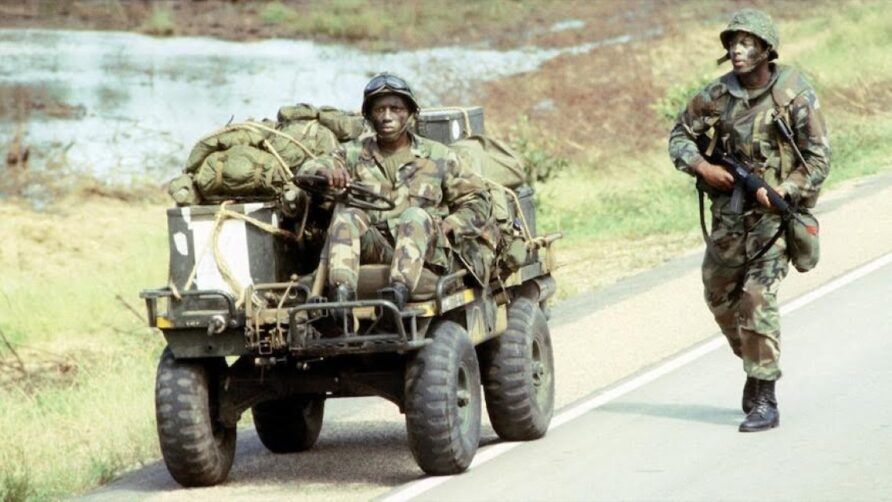
Individual soldiers would still walk, but some of their heaviest kit, rides, except perhaps sometimes, they might not.
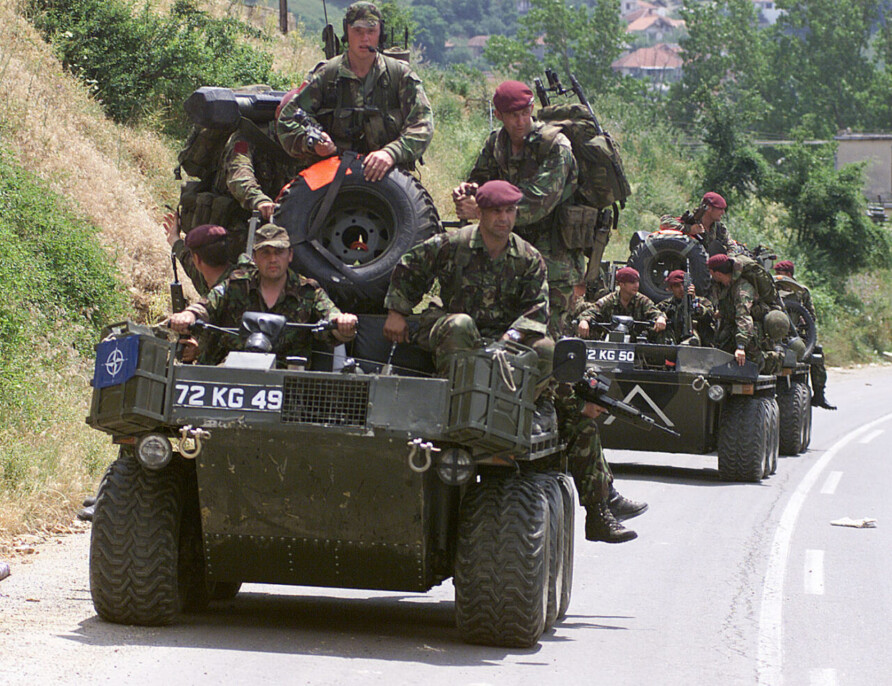
A typical light role battalion would need 20-25 such vehicles; 9 for the platoon HQs and 6 each for fire support and CQMS/Company HQ elements. Whilst the vast majority of personnel would still be walking, this is an increase in inter theatre lift requirement and why intermodal transport is so important, it cannot be ignored. Intermodal transport means we have to think in either 463L pallet or ISO container dimensions and ensure any solution maximises packing density for both.
By air…
Deploying by air would ordinarily involve simply driving the vehicle onto a tactical transport aircraft like an RAF A400M or C-17 and so as long as any vehicle is within the loading gauge for these aircraft, pallet considerations would not be a requirement. Given the likely small size and weight of them, this should not be a problem. For such smaller and lighter vehicles, and situations where tactical aircraft are in short supply, or simply not needed, strategic and civilian aircraft can be used, e.g. RAF Voyagers and civilian cargo aircraft.
Although the image below is not an Airbus A330 (Voyager), it does provide a good illustration of what a typical wide-body airliner’s lower deck looks like.
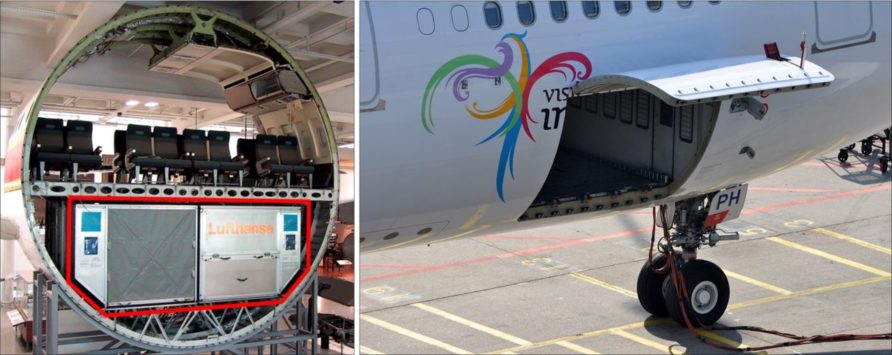
Those aluminium containers on the lower deck, indicated by the red outline, are called LD3 Unit Load Devices, more often than not, stuffed with travellers’ suitcases. Outsize cargo on flat pallets can also be accommodated although the size is limited by the dimensions of the cargo door and so used infrequently, It is possible though. If we look at the lower deck of an RAF Voyager, it can carry a combination of military 463L pallets and civilian LD3 and LD6 containers, potentially 8x 463L, 1x LD6 and 1x LD3, 25x LD3 or 13 LD6 and 1 LD3
With the appropriate pallet, and assuming any vehicle is within dimensional and weight constraints, it could be potentially transported on a Voyager. VRR manufacture a ULD called the AMF/LD36 that is compatible with the Airbus A330 lower deck.
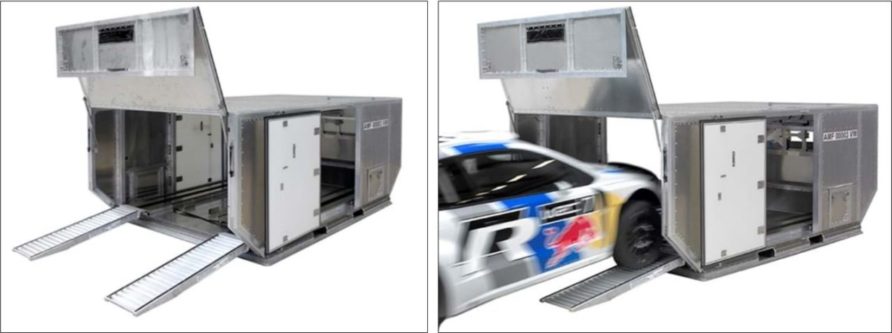
The internal base dimensions are 3.16m x 2.44m, with a maximum height of 1.6m, this should be one of the constraining dimension considerations, i.e. a small car
The second type of aircraft pallet to consider is the more common 463L, (also known as the HCU-6/E), which has a useable footprint of 2.13m by 2.64m. Two pallets can be linked together with couplers if required. Using a 463L does allow vehicles to avoid having to be driven on and off tactical cargo aircraft but the benefits of this are marginal. The real advantage is their ability to be carried on civilian cargo aircraft, or military ones that are derived from civilian aircraft, with cargo upper decks, e.g. an A330 MRTT Cargo/Tanker.

For lighter and lower vehicles, racks (called VRA) are also available to allow them to be stacked vertically for transport, maximising volume efficiency for larger civilian cargo aircraft.
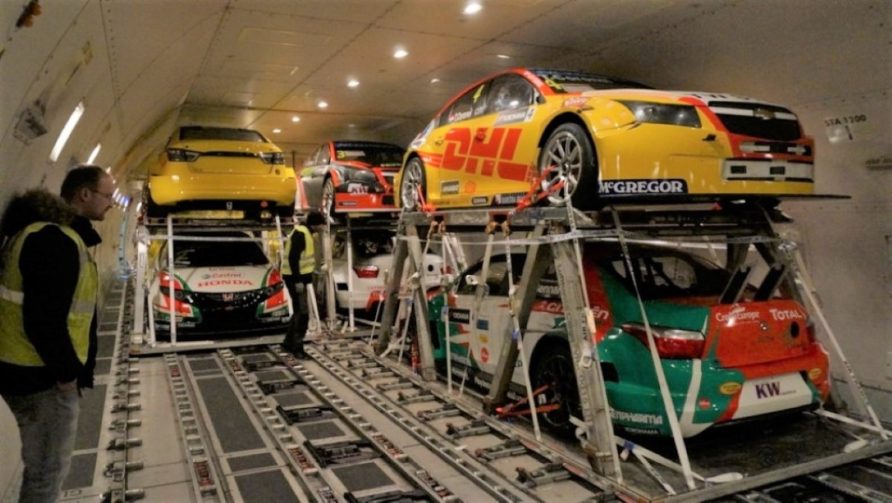
These civilian examples shown above might not be possible to replicate in a military context, different rules and regulations would apply, but they show the potential for maximising scarce aircraft volume by staying within certain limiting dimensions and utilising systems already available.
For efficient transport by air, a vehicle about the size of a small to medium-sized car opens up a lot of possibilities because of the existing civilian infrastructure. In some cases, the vehicle might be required to be carried as a helicopter underslung load. To grossly summarise a complex subject; Wildcat 1 tonne, Puma 2 tonnes, Merlin 4 tonnes and Chinook 10 tonnes.
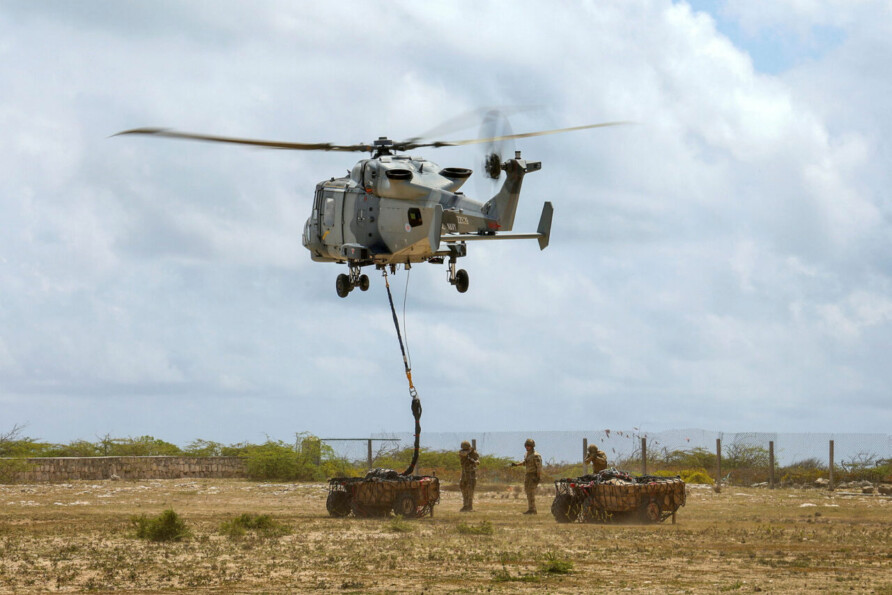
Air despatch platforms, like the ATAX Platform from Irving, feature an airbag system for heavier loads and integral shock absorption, and the flexible nature of the platform allows the platform to easily cope with ground undulation.
Each ATAX module supports a 4-tonne load and up to four modules can be combined for a maximum weight of 16 tonnes
By land and sea…
Air transport is relatively important for light role forces but more so, transport by road, rail and sea; this means ISO containers or the Army’s existing fleet of MAN SV trucks. The standard ISO containers’ numerous advantages of protection, reduction in handling and compatibility with ships, trains and vehicles are obtained when the container changes the mode of transport i.e. intermodal. Although the interior width and height are commonly quoted, the door aperture of 2.34m is more important for loading vehicles. Stacking multiple vehicles to maximise the volume of a container would also be advantageous. If the vehicle can fit within the most commonly used ISO containers it makes deployment to theatre that much easier, although not any quicker.
| Door Width | Door Height | Interior Length | |
| 1F (5ft) Quadcon | 2.34m | 2.28m | 1.5m |
| 1D (10ft) Bicon | 2.34m | 2.28m | 2.8m |
| 1C (20ft) | 2.34m | 2.28m | 5.8m |
| 1A (40ft) | 2.34m | 2.28m | 12.0m |
| 1AAA (40ft) Hi-Cube | 2.34m | 2.56m | 12.0m |
The British Army does not generally make use of 40ft ISO containers but the civilian shipping industry does, and the most common demountable flatracks are also compatible with the 20ft format. The simplest option here would be to constrain the height, width and length to that of a 20ft ISO container but there are solutions to maximising volume within a container that might be usefully considered. Aiming for the dimensions of a medium-sized car, again, unlocks various solutions in the civilian logistics market, this particular example from the UK
Put simply, this would allow typical small vehicles to be doubled up in a container, 2-3 per 20ft and 4-6 per 40ft. The Vukka Frame from UNIT45 is another interesting alternative, using half-height open container frames, 20ft or 40ft.
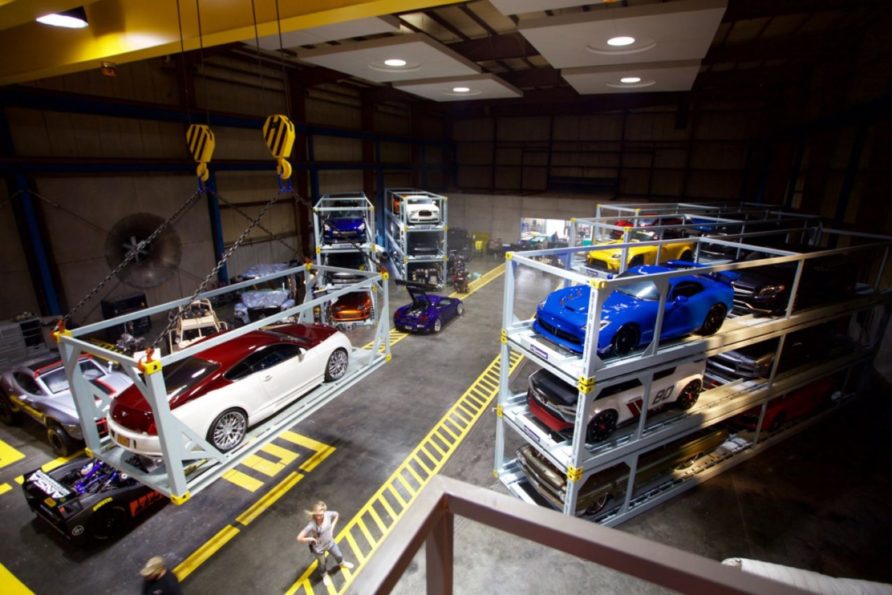
The image below is not very high quality but it shows how a vehicle like the ATMP could be stacked for efficient transport.
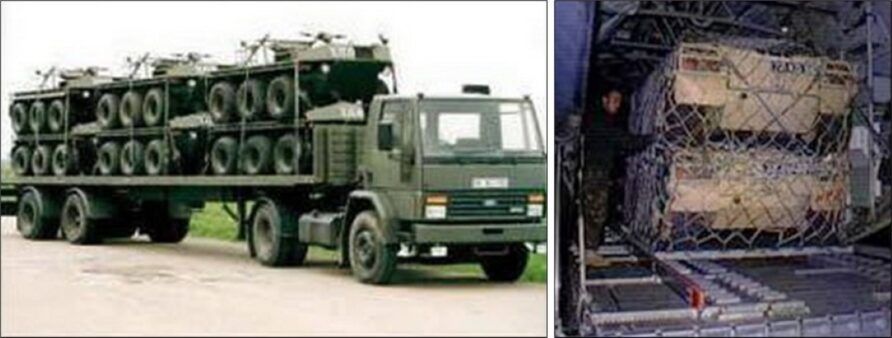
For quad-style ATVs, there are also several commercially available solutions for maximising battlegroup lift, and stacking pallets…
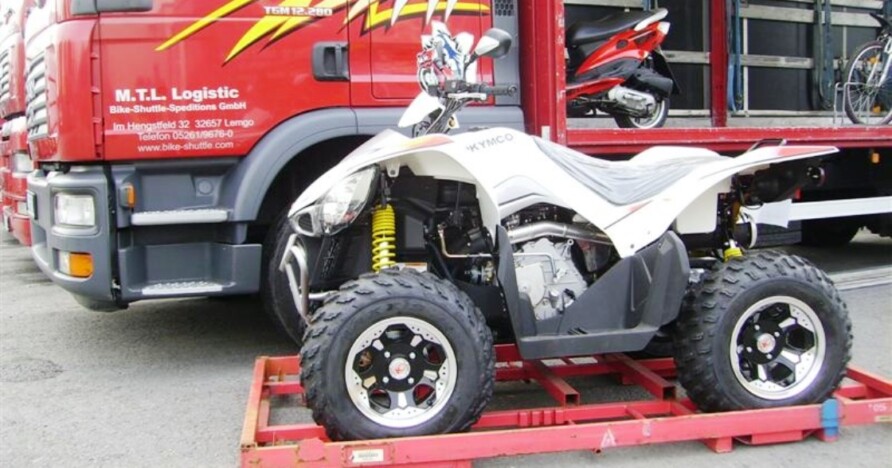
And ATV/livestock trailers can be used…

For longer moves or where some discretion is required, ISO containers can systems described above, would provide a lot of deployability benefits, as long as vehicles were constrained by the relevant dimensions and weights.
Although they may be going out of service shortly, Landing Craft Vehicle Personnel (LCVP) Mk5 can carry an approximately 6-tonne payload with a ramp width of 2m.
2 – Payload
A light-role infantry platoon carries significant a ‘collective load’; water, 7.62mm link, NLAW and batteries for example. These will be distributed across the individuals in the platoon as the platoon moves toward its objective. The actual payload could be based on various combinations of platoon equipment and stores but anywhere between 400kg and 1,200kg would seem appropriate, depending on terrain and other factors. Previous studies around the Light Tactical Mobility Platform (LTMP) from Projects PAYNE and ATLAS suggested 750kg plus for 72 hours of operation and this would be the objective. The payload area should be a simple load bed with tie-down points
Light role platoons do not hold any equipment to handle pallets so having the ability to carry a pallet might seem superfluous, but if something like the Eclipse Engineering JMIC were used, many benefits could be realised through the supply chain, in this context, have pre-packed platoon stores.

The Joint Modular Intermodal Container (JMIC) is dimensionally compatible with ISO flat racks and containers, factory to the frontline, as the strapline goes.
A simple box pallet (illustration below) would also be useful

The ability to carry a stretcher or prone casualty would be of benefit, as would a tipping load-bed or some ability to load heavier items as an upgrade.
It might be tempting to think about integrating equipment onto the vehicle but this should be avoided, nothing on the vehicle should need the vehicle to operate or be unable to be carried on foot. It is a simple load carriage device, nothing else; a crutch for the platoon commander, not something that would imperil the objective if not available. They are not fighting vehicles, nor do they provide protected mobility.
Although 750kg is the target payload, more would allow soldiers’ bergens to be carried on a long approach march.
3 – Mobility
If a vehicle has a high terrain accessibility requirement, especially in snow, muskeg/bog, intertidal areas and swamps, it will usually have to sacrifice road speed and range. The enduring ‘tracks v wheels’ debate is just as valid for this as it is for any other but for vehicles that must have low surface compaction and high tractive force, the many penalties of tracks have to be accepted. An amphibious capability may also be an important requirement, with an additional set of qualifications such as wave height tolerance or the ability to climb out of a river. Whilst we might all be in favour of cake and the eating of cake, mobility requirements have to be realistic. It is generally accepted that for serious mobility, especially where low surface compaction or high tractive force is needed, tracks are superior to wheels. Another generally accepted fact is that tracks have higher running costs, create more vibration, are noisier and have higher fuel consumption than wheels. Extra-wide tracks can reduce ground pressure even further but the additional width might push a vehicle from an internal to an external carriage.
Small wheeled vehicles can also be fitted with track units and tracks over wheels are also a common means of extending the mobility of normally wheeled vehicles.
Generally speaking, a platoon support vehicle will need to be as closely matched to the mobility of dismounted personnel as it can be, or even better. If all it has is road mobility, we might as well dispense with this whole thing and go straight to pickup trucks (maybe that is core to the debate), the role of terrain for light role infantry.
4 – Adaptability
Although I have been at pains to point out that this article has a narrow definition, simple load carriage, it should at least have a nod to being adapted for other roles, acting as a radio-rebro, providing export power for a combat pioneer section, and maybe even as a weapons carrier or UAS base station. This adaptability should come primarily from having a pallet-sized loadbed onto which systems can be fitted.

As long as the base vehicle has some modicum of excess power generation capability, the rest can be provided by batteries, fuel cells or generators integrated with the pallet. Whilst this may transfer some cost from the vehicle to the demountable pallet, it ensures the vehicle does not be too expensive for its primary role.
It would be useful to generate pallet-based ‘store packs’ for specialist functions like assault pioners, for example
5 – Other Requirements
One of the problems with recent experiments with light mechanised forces was the training overhead for the heavier vehicles that required higher classes of driving licence than commonly found in infantry units. Vehicle weights and driving licences require management and training, it is important. As an example, a Class B car licence qualifies a person to drive a vehicle with a Maximum Authorised Mass (MAM) of up to 3,500kg with up to eight passenger seats. On a Class C1 licence, vehicles with a MAM between 3,500 and 7,500kg with a trailer up to 750kg. With a C1E, the combined weight of a vehicle and trailer is 12,000kg.
Maintainability and reliability are key requirements, although simplicity does not necessarily guarantee them.
Tie-down and underslung load rigging points, self-recovery capacity, acoustic and thermal signature, power export, fuel types, maintainability, ergonomics and towing capacity, are all to be considered.
Options for Meeting the Platoon Load Carriage Requirement
Option 1 – Stay with Quads until Future Soldier and RPV are Realised
Keeping with the existing quad bike style ATVs are not altogether bad, they are in the system and have a well-established training and support infrastructure and a mass of trained users. There is a huge commercial ecosystem of suppliers and after-market accessory providers which keeps support costs down and maintainability high. They are extremely deployable on all in-service transport, mobile and very cheap to run as a fleet. Despite these advantages, needing a trailer to achieve any kind of reasonable payload is not ideal. If we aspire to the 750kg level for 72 hours of support, the numbers just don’t add up, we would need more drivers than the platoon HQ has. There are many accessories and upgrades we might consider, including new trailers, but on the whole, this option remains the most likely.
The British Army has also trialled a more powerful quad bike ATV although I don’t think any orders have been placed. This example is the Polaris MV850, able to tow a 680kg trailer.
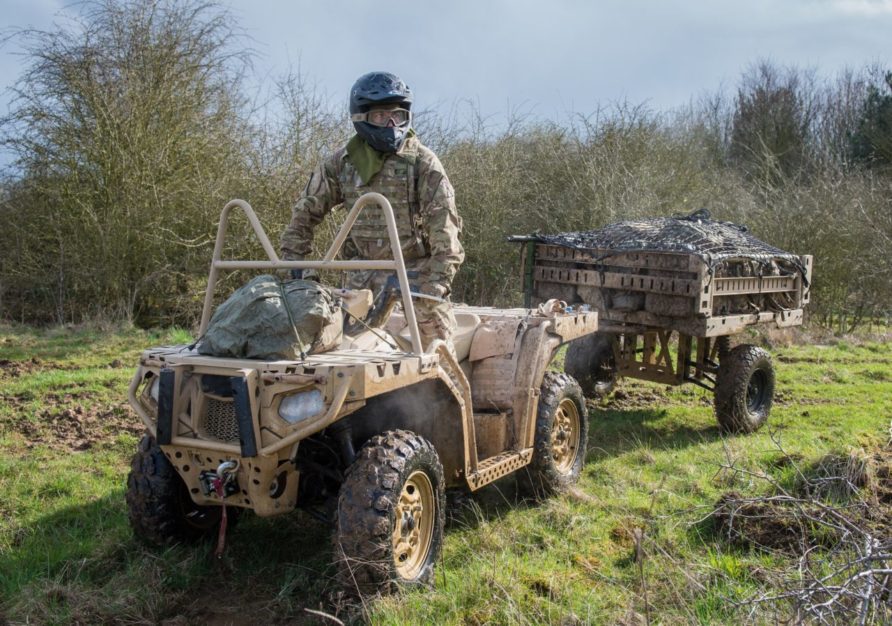
Option 2 – Upgrade to a three-axle ‘quad’
These are a relatively new concept, adding driven axle to a large quad ATV provides a decent load bed size, additional passenger seat and much larger payload without needing a trailer. All wheels remain driven for improved mobility, although an unpowered trailer can still be used.
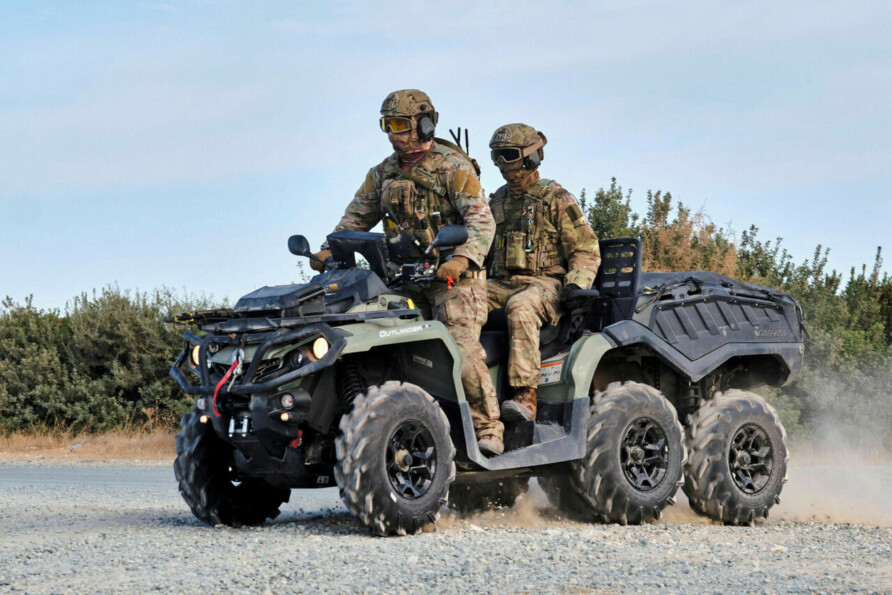
The image above shows a Can-Am Outlander 6×6, with a maximum payload of 318kg on the rear deck and can tow an unbraked trailer with a maximum weight of 907kg.
45 Commando Royal Marines have recently trialled a Can-Am 6×6 with their mortar platoon.

To achieve the 750kg target payload, two per platoon HQ would be needed, unless a trailer was used. One plus trailer would be the cheapest option
As with quad bike ATVs, they are usually no higher than 1.3m. This means they can easily be carried as an internal load on Chinook and Merlin, as in an AMF/LD36 lower deck container for air transport. The width tends to be 1.3m and most have a length of approximately 3m. Their length puts them beyond a single 463L pallet but because they are relatively narrow, two pallets clipped together can easily fit two of these. Their dimensions are not especially efficient for ISO containers as they are too wide to be placed side and side, and too long to be placed side-on. As with conventional quads, easily handled by telehandlers and forklifts using standard pallet frames. Their lack of a pallet-sized loadbed and inability to be fitted with a stretcher are disadvantages to consider.
Even with those disadvantages noted, with a cost of less than £20k each and a significant commercial ecosystem, there is a lot to be said for these. Equipping a Light Role Battalion as described above, half a million quid.
Option 3 – Side by Side ATV
Although payload and performance tend to be comparable to the 6×6 quads, side-by-side ATVs provide improved driver/passenger protection and in many cases, a larger load bed. They are more common than the 3-axle quad bike ATVs and are used widely in the agriculture, outdoor sports and construction sectors. As with quad bike ATVs, the large volumes and supporting ecosystem of manufacturers and integrators work in our favour. Manufacturers include Polaris, Bobcat, Yamaha, John Deere, Honda and Tracker. Sizes and capacities vary with some focussing on load bed space and others replacing that with seating, long and short wheelbase variants are commonplace with most of the manufacturers.

As defence customers have refined requirements, these civilian-derived models have been increasingly modified, with Polaris and John Deere appearing to dominate the market. To allow internal carriage, demountable rollover protection has replaced enclosed cabs. The John Deere Gator family have been adapted by International Automated Systems for defence markets and called the Mach 2 and Mach 2XL, the latter having a stretched load-bed. Both have diesel engines and a maximum speed of 50kph. The fuel tank holds 26 litres and they have a maximum weight of just over 1,500kg, with a payload of 530kg.

Polaris makes a similar model with demountable rollover protection, the MRZR Alpha 2 and 4. This is quite an advanced design with exportable power, and sling load attachment points and is available in two and four-seat models. The two-seat model has a rear bed payload of 272kg. Both have a range of approximately 360km.
A couple of other interesting vehicles are the Australian Bale Defence RTV Death Adder and French Unac Rider, the former of which has quite a high payload for this type of vehicle. Larger Polaris models like the DAGOR have been trialled by the Royal Marines but I have excluded this
These types of vehicles do not offer a huge payload advantage over the ride-on ATVs for a higher cost and without any of the dimensional advantages. The passenger cab makes them too tall for internal carriage in a Chinook or Merlin without ROPS removal, and with a length of 3m, they do not fit inside the footprint of a 463L pallet. Because of their width, only one would fit on a double 463L as well. The short wheelbase models are generally small enough to fit inside an AMF/LD36 and with ROPS removed, easy to exploit the ISO container racking options described above. The load-beds are generally larger than any of the ride-on ATVs and some could easily accommodate a pallet. Mobility seems to be focused on harder surfaces and higher speeds/longer ranges.
Although many in the defence market seem smitten with them, with widespread adoption by SF and air mobility forces, for this application where low cost, mobility and payload are kings, I am less keen.
Option 4 – Farmers Markets
Taking a look outside of the defence markets can often reveal several surprises.
The Caron EVO 4/5 is an agricultural utility vehicle available as an articulated or steering wheels version, the centre articulation ensures high levels of wheel contact with the ground when moving across undulating terrain.
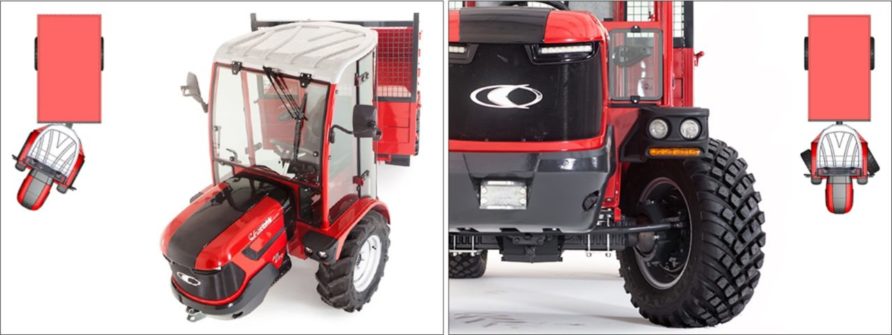
It can be fitted with an enclosed cab (that can be pressurised for use when spraying) or an open protection frame, and the rear loadbed has a tipping function.
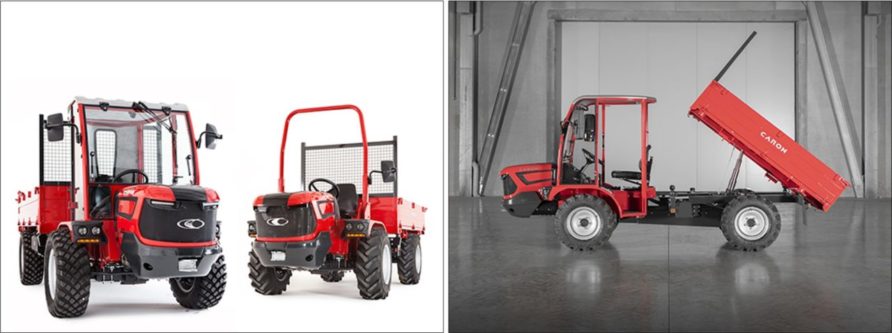
The smallest of the range is called the Evo 5 100 and has a total maximum weight of 3,500kg (Class B licence), where the payload is a whopping 2,000kg of that. With a top speed of 40kph, they are hardly the fastest vehicle on this page but do they have to have high speed? With the protection, and frame lowered they could easily fit inside a Merlin or Chinook, and would also be low enough to use an AFM/LD36 container. Two could also be fitted on a double 463L pallet. The load-bed is 2.56m long by 1.25m wide which means they would be able to carry two NATO standard pallets. Two fully loaded NATO pallets (which would be slightly over max payload) could include 256 81mm mortar rounds, just under 40,000 7.62mm rounds, over 1,000 litres of fuel in 25 Litre jerrycans or 800 operational ration packs, much more than the objective of 750kg. A braked trailer would double these and the whole package would still be inside Chinook dimensions and weight limits.
Larger versions are available that increase the maximum weight to 5,000kg, with a payload of 3,500kg, and with a nod to the adaptability requirement, it has been fitted with several hydraulic attachments and tank bodies.

Am not sure how much is new, but when I looked on a couple of European equipment trader sites nearly new models with less than 20 hours of usage were going for around twenty thousand Euros, just to get an idea of likely new costs. Probably no more than three-quarters of a million Pounds for a complete battalion’s worth. Compare these with a sit-on 6×6 ATV, arguably a little less mobile but for a similar cost and real-world deployability, a payload SIX times higher, and that is before we even consider trailers and adaptability for other roles.
Consider the image below, Royal Marines 45 Commando mortar troop with Can-Am 6×6 sit on ATVs
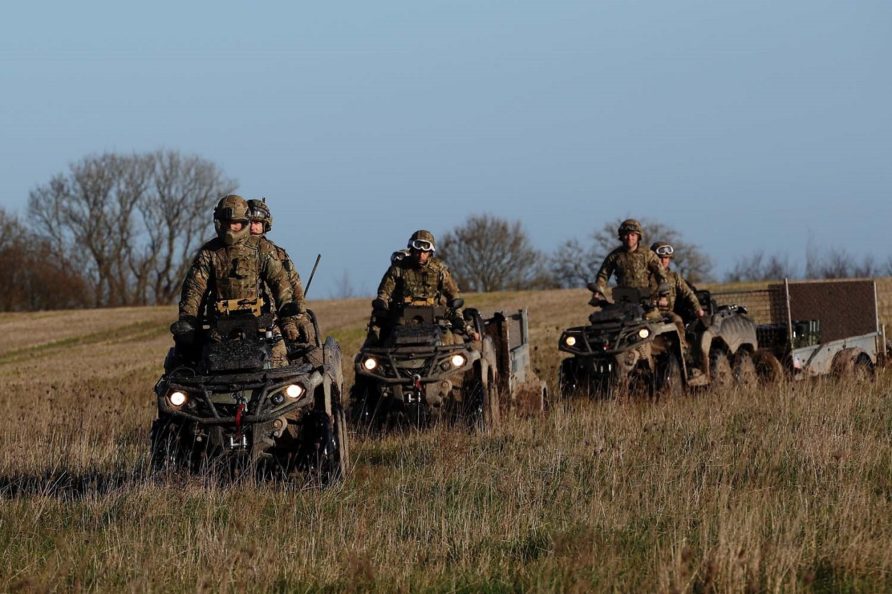
A very rough comparison of the numbers
| Total Length | Vehicle Weight | Max Payload | Cost Estimate | |
| 3x Can-Am 6×6 | 9.6m | 1,800kg | 1,200kg | £60k |
| 3x Can-Am 6×6 with trailers | 17.0m | 2,100kg | 3,900kg | £65k |
| 1x Evo 5 100 | 4.2m | 1,500kg | 2,000kg | £30k |
| 1x Evo 5 100 with trailer | 7.5m | 1,800kg | 4,000kg | £32k |
| 2x Evo 5 100 | 8.4m | 3,000kg | 4,000kg | £62k |
These are, self evidently, not comparing apples and apples, and there are advantages and disadvantages for each approach. Using three ATVs means 6 personnel can be carried and they can be distributed for survivability, but that also means three engines to maintain, and the total length is significant if internal carriage inside a Merlin or Chinook is an important factor. Mobility with a trailer is also degraded and the carried weights shown in the table assume a braked trailer, unlike the ones in the image above. Unbraked trailer payloads are usually much lower. Adaptability with a sit-on 6×6 is low, they cannot carry a NATO pallet or stretcher without using a trailer. The EVO has a hydraulic pack which means it could be very useful for assault pioneers, even able to carry a sit-on micro-excavator like the Yanmar SV108, and has enough space to carry an electronics shelter or other payload like an Easibridge kit.
Another design, the PK600 AWD from Grillo in Italy has a tipping load body that could comfortably carry a NATO standard pallet it weighs in at 1,150kg yet has a payload of 900kg, with a maximum speed of 40kph
Now I would be the first person to recognise the essential lack of cool, but I cannot ignore the numbers either, put aside the embarrassment of farmers’ wagons and glorified sit-on mowers, payloads are high, costs are low, deployability is good
What’s not to like?
Option 5 – Multi Axle ATV
Whilst side-by-side ATVs are generally derived from the sports utility and agricultural markets, 6×6 and 8×8 type ATVs come from a much smaller market niche that demands very high levels of mobility in poor terrain. Many of the current crops of robotic platforms are also derived from a small number of ‘source manufacturers’ such as Argo, Hydratek and MaxATV. The Lockheed Martin Squad Mission Support System (SMSS) is based on the Hydratek Land Tamer base vehicle and the Rheinmetall Mission Master ‘Silent Partner’, is based on an Argo XTV, for example.
A few years ago, the MoD trialled the Hippo-X from Multipower, supported by Pardus Defence and Security. The Hippo-X is derived from the Mudd Ox XL with additional military and power export features. Fully amphibious, it weighs about a tonne and can carry a tonne (although half that when amphibious), a one-tonne trailer can also be towed.
The performance of the Mudd Ox is higher than even the largest Argo model, they are very impressive machines and Mudd Ox continues to develop them. At the smaller end of the scale, the MXI Buffalo Trucker is a 6×6 amphibious unit with a tilting load bed, a 500kg payload on a 500kg highly durable polyethene body, also impressive. The South African Gecko is now owned and produced by LMT Holdings. It weighs 1.2 tonnes, can carry 900kg and pulls a 1-tonne trailer. It is a well-realised platform with several trailer options including one that has a ‘command and control’ pallet, and a palletised communications rack.
Hippo and Pardus seemed to have moved away from Mudd-Ox with their current marketing material and are now offering a different vehicle, the Raptor and HIPPO HAWC (Hybrid Amphibious Wheeled Carrier). Both of these are based on a chassis designed and developed by Canadensys
The HAWC is quite an advanced design, it has a payload of 750kg and can tow a 2-tonne trailer (or Light Gun). It has a hybrid system that can provide power for offboard systems and enable some degree of silent running. Gross vehicle weight is under 3 tonnes so would be an easy lift for a Merlin or Chinook and it can be carried inside a Chinook. Finally, it can be fitted with an autonomous guidance and steering system.
Perhaps more familiar to the British Army is the Supacat ATMP.
The Supacat All Terrain Mobility Platform was developed in response to a requirement identified after the 1982 Falklands Conflict, namely, a high mobility load carrier for light role forces. After competing with Esarco, it entered service in the mid-eighties. There is no need to tell its long back story here, so click here to do so. The fact remains that ATMP came from a specific military requirement, it is not an adapted civilian design. Although the basic design remains, it has been subject to continuous improvement and development, including electric propulsion and autonomous guidance.
The Supacat All Terrain Mobility Platform (ATMP) is a 6×6 design that uses low-pressure Terra-Wrangler tyres to deliver a ground pressure of only 0.2 kg/cm, making it highly mobile on soft ground. Originally powered by a 1.3L Citroen engine, the later versions had a 1.5L VW-Audi engine and automatic transmission. Specifications included a 750-1,000kg payload, increasable to 1,600kg with reduced performance, a maximum loaded weight of 1.6 to 1.8 tonnes, limited amphibious capability, and a top speed of 65kph with permanent 6-wheel drive.
Because the focus for ATMP was air manoeuvre and logistics, a great deal of thought was put into cargo handling ad weight/dimensional compatibility with in-service aircraft. Air portability was a key requirement; they can be parachute dropped on Medium Stressed Platforms (2 per platform), carried by helicopter as a sling or netted load and are internally transportable in a Chinook. Given the length of time, the ATMP had been in service, all necessary Joint Air Transport Establishment (JATE) clearances were obtained for different aircraft and loading schemes. Chinook was cleared to carry 2 ATMPs internally without lowering the roll cage or 4 as a single underslung load. Merlin internal carriage, Puma underslung load and even the Blackhawk were certified. Multiple stacking options also exist for carriage in larger aircraft such as the C130 and C17. The ATMP and air portability go hand in hand
Vehicles like ATMP really shine in the logistics role, the load-carrying and towing capacities are extremely impressive. Aided by smart design such as an integral winch and pair of ramps that were stored in internal compartments parallel to the vehicle’s long axis, pallets could be simply winched onto the ATMP load bed, secured and the vehicle drove away. A pair of specially developed trailers were also introduced to increase overall load-carrying capacity, the FLPT (Fork Lift Pallet Trailer) and SLLPT (Self Loading Lightweight Pallet Trailer). As an illustration of the adaptability of the vehicle, the GKN FuelCat was a system designed to support Forward Arming and Refuelling Point (FARP) operation for helicopters and fixed-wing aircraft. One vehicle contains a generator, pumping equipment and fuel tank, and the other, a crane and trailer for another fuel container and pipelines. Between the two vehicles, they can carry 4,000 litres of fuel, pump it to multiple aircraft simultaneously and, provide aircraft towing and a gas turbine starting rig.
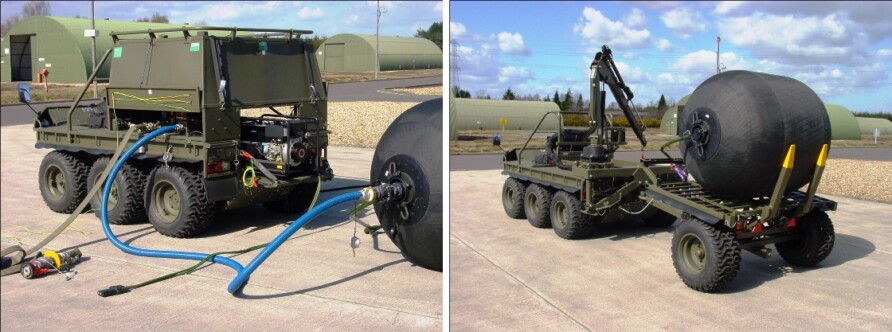
There is a wealth of multi-axle ATVs available, all of them good. These have also formed the basis for several autonomous or robotic vehicles. Argo, Hippo, and Mud Ox all have very strong offerings but they have little or no footprint in the UK and most parts would be at the end of a long supply chain. This is one of the reasons I would favour Supacat ATMP. The ATMP is a proven solution, simple and effective. It has also been the beneficiary of a significant UK taxpayer investment and MoD clearance qualifications. Thoroughly military, if this type of vehicle was the answer, the offshore alternatives would, at least for me, have to offer some very clear performance advantages.
Option 6 – Tracked Vehicle
If mobility over deep snow, bogs and mud is an absolute requirement, adopting a small tracked vehicle might be a sensible option, especially now the modern generation of continuous rubber tracks is so mature. Any small ATV can usually be fitted with after-market track kits, and ski-equipped trailers are also available. For light role forces, simply adopting these would provide additional mobility for some solid and snow conditions without purchasing completely new vehicle types. However, there are a handful of small tracked vehicles that might be suitable.
The Canadian Alltrack AT-20HD has a kerb weight of just over 2,700kg but with a payload of nearly 1,600kg, has a gross weight of 4,309kg.
The UK-manufactured Loglogic Softrak 75, one of which is actually in use as an MoD range vehicle. It has a kerb weight of 2,550kg and a payload of 2,000kg, with hydraulic and hydrostatic power take-off should it be needed.

With a top speed of 16 kph, it would take some to cover any distance but with a ground pressure of less than 2PSI, its terrain accessibility is excellent.

It can use a tracked or wheeled self-loading trailer and is available in a couple of larger sizes. The load body can be replaced with a tipping body or an 8-seat crew pod (in addition to the three seats in the cab).
It can also be fitted with a demountable cargo module, akin to a manual DROPS style arrangement.
None of these is amphibious but the Hydratek produce both 6×6 and 8×8 models with over tracks, the D2488B, for example, has a 1.4-tonne payload and can tow a 4.5-tonne trailer.
These small tracked vehicles are quite simple and remarkably capable, with very high payloads. Tracks might not automatically be the answer, but they should be a strong contender if high terrain accessibility is a key part of any emergent requirement, and we make one of them in the UK, which has already sold into the MoD. Although slightly larger than the side-by-side ATVs, with a removable rollover protection system, are low compact enough to be carried in an AMF/LD36. Two 463L’s would be needed for one container but it would pack two into an ISO container with suitable tilt racking. The 2.2m width makes them marginal for internal Chinook and Merlin carriage
These would also be very adaptable for additional purposes, especially the Softrak 75 because of its large load-bed and hydraulic power pack.
Option 7 – Bespoke Design
Although unlikely, it is not completely ridiculous to suggest a bespoke design, one perhaps even based on old classics like the Mechanical Mule

or Faun Kraka.

With modern materials, their already impressive performance could be improved even further, the Faun Kraka, for example, could be folded to assist with helicopter carriage and had a 750kg payload.
We did do this, not all that long ago. In 2005 the MoD contracted with Roush Technologies Ltd under Project Harewood to design and build an ultra-lightweight all-terrain load-carrying vehicle that could be an underslung load by a Lynx helicopter and internally carried in a Merlin and Chinook, called BALTER. The contract was worth £3.3m but only 15 vehicles entered service and have all since been disposed of. What was unusual about Balter was it was designed from scratch to be a military vehicle, not adapted from agriculture or recreational designs. It had a multi-fuel engine (diesel, JP8, JP5 and B20 biodiesel), NATO-compliant electrical system and tie-down and sling load points. Under its Lola Composites aluminium honeycomb construction, it only weighed 800kg yet could carry a 1,000kg standard pallet. A lightweight trailer could be used to increase the payload by another 600kg. Roush developed the concept into a 2-seater with a load bed shelter and uprated engine developing 50 kW and 160Nm of torque. The Roush Balter (LAS100RE) is an interesting case study in simplicity and weight reduction although the manufacturer has since moved on to other things.
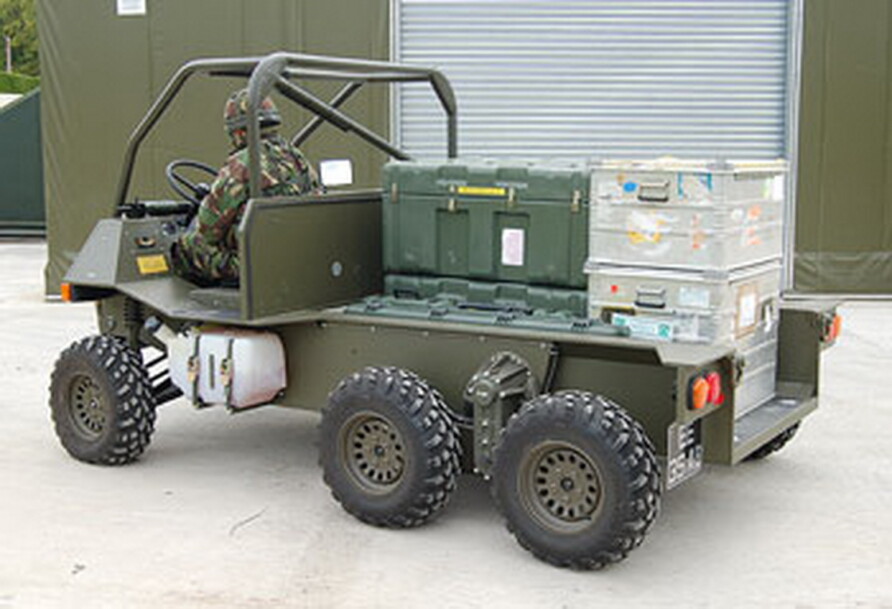
Summary
Assuming there is a requirement for light role infantry to have some sort of load carriage support vehicle, and I think there is, rather than completely mechanising them, there is a wide range of options. The problem the British Army faces is the conflict between solving the problem now with a simple compromise solution, or waiting until the robotic programs are delivered.
Last-mile autonomous logistics is probably the most difficult to solve, and arguably, has the lowest payoff. Complex physical and human terrain is going to require vast investment in time and resources to realise any kind of deployable solution. Experience tells us any such complex solution, with two heavy shopping bags of requirements attached, provided by multiple system integrators and subsystem providers, at the end of complex international supply chains, is going to cost a large sum of money. It will also require a significant investment in training at the battalion level and lots of technical support to maintain service.
It is not my place to second guess their leadership, but from the outside, it looks like the British Army is as poor as a church mouse, with a payday loan and an expensive cheese-on-toast habit.
Can it afford to develop, implement AND maintain such a capability?
I don’t mean to sound too cynical, rubbish the considerable investment or dismiss the huge potential, but the problem with vehicles where the sensor package costs more than the vehicle is we just won’t buy enough to make any tangible difference, perhaps we need something that costs the same as a car, not a house. Meanwhile, there is a carried weight problem right now, we cannot wait for the perfect mousetrap. Solutions exist today, the problem can be resolved today, and none would require massive amounts of money. Those solutions are also available from UK manufacturers, simple commercial relationships with no complex systems’ integration.
Oh, and intermodal transport is critical for this requirement, but you know that already!
Before reading on, would you mind if I brought this to your attention?
Think Defence is a hobby, a serious hobby, but a hobby nonetheless.
I want to avoid charging for content, but hosting fees, software subscriptions and other services add up, so to help me keep the show on the road, I ask that you support the site in any way you can. It is hugely appreciated.
Advertising
You might see Google adverts depending on where you are on the site, please click one if it interests you. I know they can be annoying, but they are the one thing that returns the most.
Make a Donation
Donations can be made at a third-party site called Ko_fi.

Think Defence Merch
Everything from a Brimstone sticker to a Bailey Bridge duvet cover, pop over to the Think Defence Merchandise Store at Red Bubble.
Some might be marked as ‘mature content’ because it is a firearm!
Affiliate Links
Amazon and the occasional product link might appear in the content, you know the drill, I get a small cut if you go on to make a purchase
Discover more from Think Defence
Subscribe to get the latest posts sent to your email.


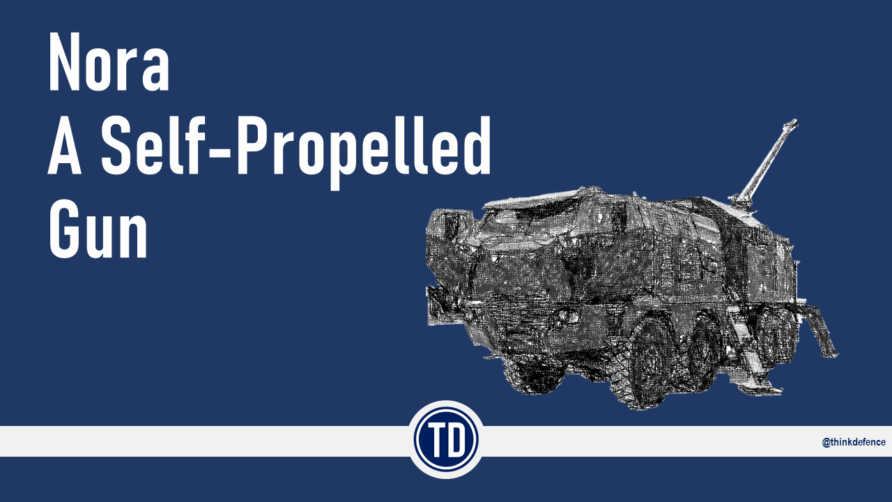
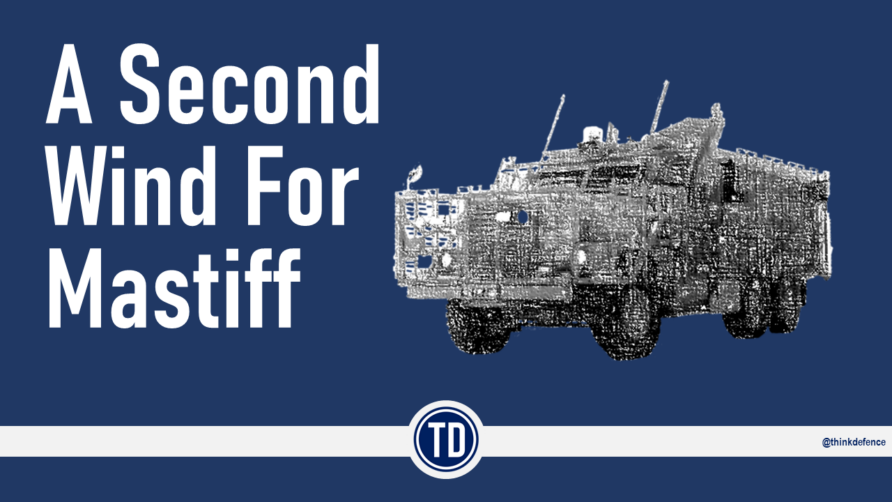
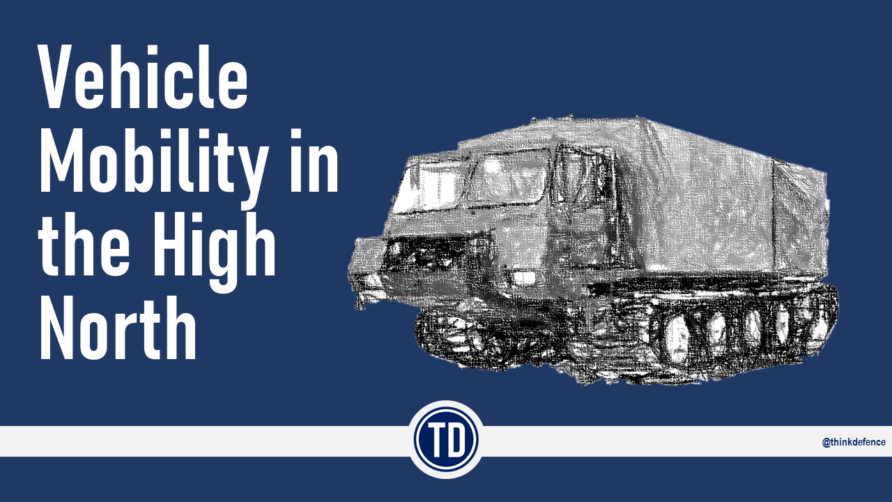
Great read TD
I’ve been thinking, is there maybe an ultra minimalistic solution for infantry load?
as in – a standard wooden pallet takes 160kg plus. Bolt on a 500w electric motor, 4 bicycle wheels and the rfid from a toy car and you’ve got a platform that can take 20kg off each man in a section for about 300£ tops. If it breaks throw it away.
Just a thought
Great review of a wide arena.
I wonder which (past) project gave TD the inspiration for this little golden nugget?
“any such complex solution, with two heavy shopping bags of requirements attached, provided by multiple system integrators and subsystem providers, at the end of complex international supply chains are going to cost a large sum of money”
I love the old Mechanical Mule! Cheap, simple, does the job and looks funky too! Those Caron tractors are very impressive, but no doubt the Sext bikes look better in the recruitment videos…
As for those automatic jobbies, I can’t help but cringe. You just know they ll need to be rescued by a human every time they don’t turn up/get lost/breaks down/gets stuck/rolls over or otherwise shits itself. They all rely on GPS, which can be jammed, and what about EMP? And stupidly expensive.